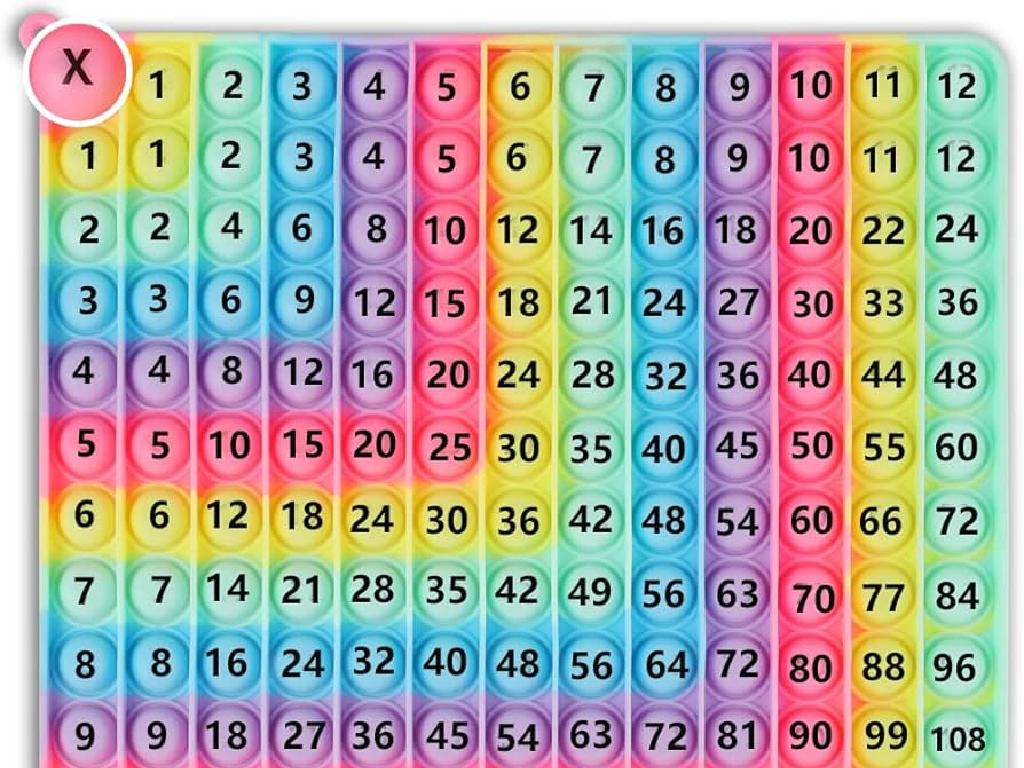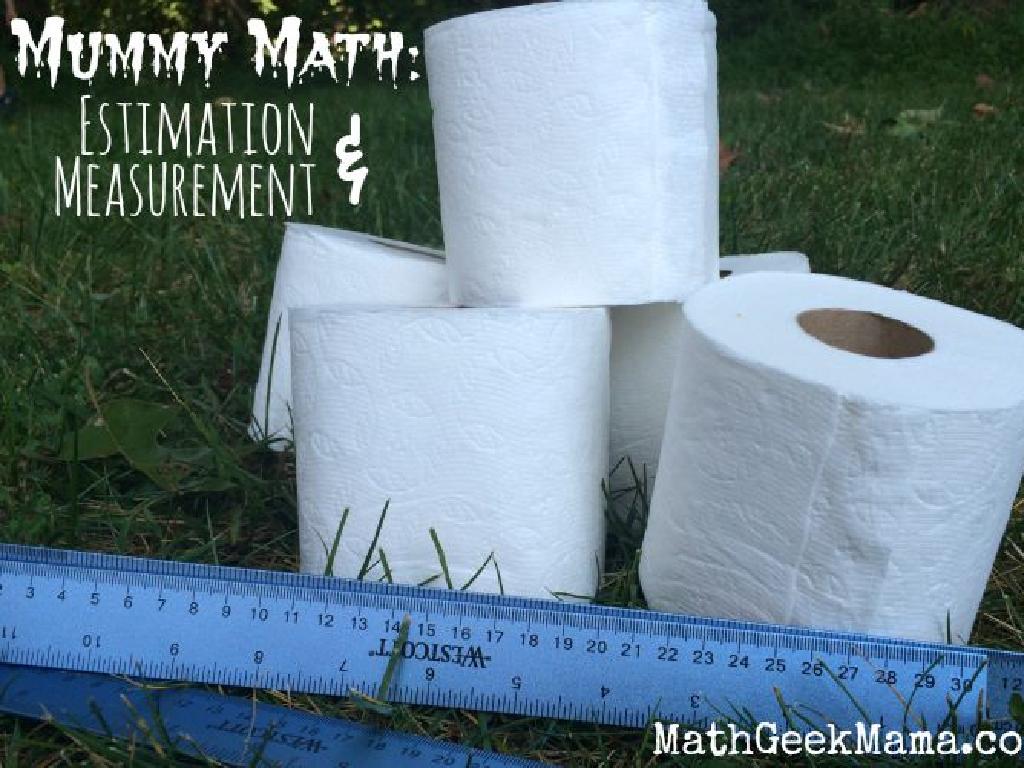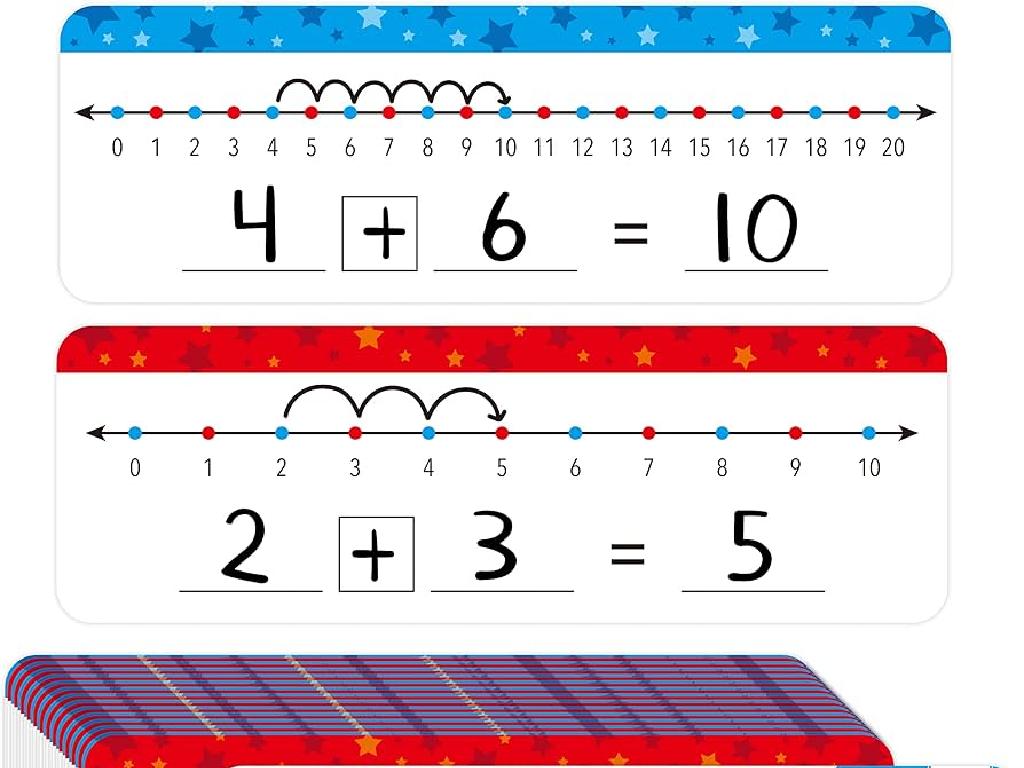Division Facts For 6, 7, 8, And 9: True Or False?
Subject: Math
Grade: Third grade
Topic: Division Fluency Up To 10
Please LOG IN to download the presentation. Access is available to registered users only.
View More Content
Welcome to Division Facts!
– Learn division for 6, 7, 8, 9
– Understand how to divide by these numbers
– Division is like equal sharing
– Imagine splitting snacks evenly with friends
– Practice true or false statements
– We’ll look at examples and decide if they’re correct
– Mastering division fluency
|
This slide introduces the concept of division facts for the numbers 6, 7, 8, and 9. The goal is to help students understand division as a method of sharing equally, which is a relatable concept at this age. By comparing division to sharing with friends, students can visualize the process and grasp the concept more easily. The class will engage in activities where they determine the truth of division statements, reinforcing their understanding of division facts. It’s important to ensure that students are comfortable with the idea of division before moving on to more complex problems. Encourage participation and use real-life examples to make the learning process interactive and fun.
Understanding Division
– Division: A basic math operation
– Explains how many times one number fits into another
– Example: 8 divided by 4 equals 2
– 8 can be divided into 2 groups of 4
– Practice with 6, 7, 8, and 9 division facts
– Use true or false questions to test understanding
|
This slide introduces the concept of division, which is one of the four fundamental operations in mathematics. It’s crucial to convey to the students that division is essentially about determining how many times one number is contained within another. Use simple examples like 8 divided by 4 to illustrate this point. After explaining the concept, transition to practicing division facts for 6, 7, 8, and 9. Encourage students to think of division as the process of evenly distributing a number into smaller groups. To reinforce learning, provide true or false statements for the students to solve, ensuring they understand the division facts for these numbers. This activity will help build their division fluency up to 10.
Division Facts for 6: True or False?
– Understanding division by 6
– Dividing numbers into groups of 6
– Think of sharing 18 cookies with 6 friends evenly
– Can 18 be divided by 6?
– Yes, 18 has 3 groups of 6 (18 ÷ 6 = 3)
– Practice with more examples
– Try 24 or 30 divided by 6 and see what you get!
|
This slide introduces the concept of division by 6. Start by explaining that dividing by 6 means making equal groups of 6 items. Use relatable examples like sharing cookies among friends to illustrate the concept. Confirm that 18 can be evenly divided by 6 by showing that it makes 3 equal groups. Encourage students to practice with more examples, such as 24 or 30, to reinforce the concept. Make sure to check for understanding and correct any misconceptions about division facts.
Division Facts for 7: True or False?
– Understanding division by 7
– Dividing numbers into groups of 7
– Is 28 divided by 7 equal to 4?
– True! 28 divided by 7 equals 4
– Checking our division fact
– Use objects or drawings to make 7 groups and count
|
This slide is aimed at helping third graders understand division with the number 7. Start by explaining that dividing by 7 means making groups of 7. Use the example of 28 divided by 7 to show how to check if the division fact is true. Encourage students to visualize the problem by using objects or drawings to create 7 equal groups and then count the total in each group to verify that there are indeed 4. This hands-on approach helps solidify the concept of division and reinforces the fact that 28 divided by 7 is 4. Make sure to affirm that the statement is true and praise the students for their problem-solving skills.
Division Facts for 8: True or False?
– Understanding division by 8
– Making groups of 8 in division
– Imagine sharing 8 apples evenly among friends
– Is 32 divided by 8 equal to 4?
– We’ll use division to see if 32 can be split into 4 groups of 8
– Practice with more examples
– Try dividing 40 or 24 by 8 and see what you get!
|
This slide is aimed at helping third graders understand the concept of division by making groups of 8. Start by explaining that division is similar to sharing things equally. Use tangible examples, like dividing 8 apples among friends, to illustrate the point. Then, present the problem 32 divided by 8 and solve it together with the class to show that it equals 4. Encourage the students to practice with more examples, such as 40 divided by 8 or 24 divided by 8, to reinforce the concept. The goal is to build fluency in division facts for the number 8 through practice and verification of true or false statements.
Division Facts for 9: True or False?
– Understanding division by 9
– Making groups of 9
– Imagine sharing 9 cookies evenly
– Is 45 divided by 9 equal to 5?
– Use counters or drawings to see if 45 can be split into 5 equal groups of 9
– Practice with more examples
– Try dividing different numbers by 9 and see what you discover!
|
This slide focuses on the division fact for the number 9. Start by explaining that dividing by 9 is like making equal groups of 9 items. Use visual aids like counters or drawings to help students visualize the concept. For the example, show how 45 can be divided into 5 equal groups of 9, confirming that 45 divided by 9 is indeed 5. Encourage students to use objects or drawings to practice this with different numbers. The goal is to help them see the pattern and become fluent in dividing by 9. In the next class, students can share their findings and discuss any patterns they noticed while practicing.
True or False Division Game
– Time to play a division game!
– I’ll show a division fact on the board
– Example: Is 42 ÷ 6 = 7 true or false?
– Decide if it’s true or false
– Think: Does 6 times a number equal 42?
– Get ready to use your division skills!
– Practice makes perfect with division facts!
|
This interactive game is designed to test the students’ knowledge of division facts for 6, 7, 8, and 9. Display a series of division statements on the board and have the students use their division skills to determine if the statement is true or false. Encourage them to think about the related multiplication fact to verify their answer. For instance, if the division fact is 42 ÷ 6 = 7, they should multiply 6 by 7 to see if it equals 42. This activity will help reinforce their understanding of division and improve their fluency. Prepare a variety of examples and be ready to offer guidance as needed. Celebrate correct answers and provide support for mistakes, ensuring a positive learning environment.
Class Activity: Division Bingo
– Get ready for Division Bingo!
– Each student receives a bingo card
– Cards have division facts for 6, 7, 8, 9
– Solve division facts to mark squares
– Use division fluency to find answers
– Five correct in a row wins!
|
Division Bingo is a fun and interactive way to help students practice and reinforce their division facts for 6, 7, 8, and 9. Distribute bingo cards that have different division facts up to 10. As the teacher, you will call out division problems, and students will solve them and mark their answers if they appear on their cards. The goal is to get five correct answers in a row, either horizontally, vertically, or diagonally. Prepare small prizes or rewards for winners to motivate participation. This activity not only promotes division fluency but also encourages listening skills and quick thinking. Make sure to rotate the calling of problems so all students have a fair chance of winning.






